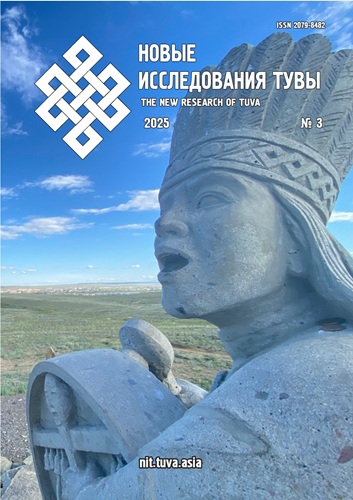Comparative Study of Tuvan Literature: Approaches and Methods
DOI:
https://doi.org/10.25178/nit.2025.3.1Keywords:
Tuvan literature; literary comparativistics; historical-typological method; mythopoetic method; transculturality; Turkic-language literature; Tatar literatureAbstract
The article presents a systematic analytical review of comparative studies of Tuvan literature and Turkic-language literatures. The relevance of the research is determined by theoretical inquiries in the field of literary comparativistics, a revision of its methodology, and the emergence of new directions in comparative literary studies. The analysis of comparative research between Tuvan literature and other Turkic-language literatures (primarily those of the peoples of Central Asia) makes it possible to determine the extent to which these studies correlate with the developmental vectors of contemporary comparativistics and to assess the prospects for comparative study of Tuvan literary phenomena alongside those of related Turkic literatures.
As a result of the systematization, the main methods used in comparisons between Tuvan and other Turkic-language literatures have been identified. The article analyzes works based on historical-typological and historical-genetic methods, establishing that these methods, which dominated comparative research during the Soviet period, remain relevant in comparative studies of Tuvan literature.
It is determined that, quantitatively, mythopoetic studies predominate in comparisons between Tuvan literature and other Turkic-language literatures, which is attributed to the influence of mythology and folklore on the artistic thinking of Central Asian writers. The heuristic potential of works that employ the concept of “transcultural” (“translingual”) literature as the basis for comparison is revealed.
The article also analyzes studies comparing phenomena of Tuvan literature with those of Tatar literature. It is established that, in these studies, the theoretical foundation for comparison is historical poetics, which makes it possible to identify similarities and differences at the level of compositional and architectonic forms: genre structure, subject organization, and chronotope.
The article concludes by outlining possible prospects for comparative studies of Tuvan literature, which are seen in the expansion of the field of comparative research and its methodology.
References
Averintsev, S. S., Andreev, M. L., Gasparov, M. L., Grintser, P. A., Mikhailov, A. V. (1994) Categories of Poetics in the Change of Literary Epochs. In: Grintser, P.A. (ed.) Historical Poetics. Literary Epochs and Types of Artistic Consciousness: Collection of Articles. Moscow, Nasledie. 509 p. Pp. 3–38. (In Russ.)
Amineva, V. R. (2007) Hermeneutic Discourse in Comparative Studies. Uchenye Zapiski Kazanskogo Gosudarstvennogo Universiteta. Seriya Gumanitarnye Nauki, vol. 149, book 2, pp. 191–205. (In Russ.)
Amineva, V. R. (2017) Hikaya as a Literary Genre (Based on the Works of A. Eniki of the 1940s–1960s). Uchenye Zapiski Kazanskogo Universiteta. Seriya Gumanitarnye Nauki, vol. 159, book 1, pp. 7–25. (In Russ.)
Amineva, V. R. and Mizhit, L. S. (2021) Subject-Image Structures in Tatar and Tuvan Poetry of the 1970s–1990s. New Research of Tuva, no. 1, pp. 228–254. (In Russ.). DOI: https://doi.org/10.25178/nit.2021.1.13
Amineva, V. R. and Mizhit, L. S. (2023) Nasir and Shuluk-Chugaa: Variants of Prosopoetic Synthesis in Tatar and Tuvan Literatures. New Research of Tuva, no. 4, pp. 22–43. (In Russ.). DOI: https://doi.org/10.25178/nit.2023.4.2
Bakhtin, M. (1979) Aesthetics of Verbal Art. Moscow, Iskusstvo. 424 p. (In Russ.)
Valikova, O. A., Shagimgireeva, B. E. and Kuliyeva, Sh. A. (2020) Cosmos in Logos: Translingual Poetry of Eduard Mizhit and Bakhyt Kairbekov. New Research of Tuva, no. 4, pp. 230–249. (In Russ.). DOI: https://doi.org/10.25178/nit.2020.4.16
Veselovsky, A. N. (1989) Historical Poetics. Moscow, Vysshaya Shkola. 406 p. (In Russ.)
Gorshenina, S. M. (2019) Invention of the Concept of Middle/Central Asia: Between Science and Geopolitics. Transl. from French by M. R. Maizul’s. Washington, Central Asia Program, George Washington University. 119 p. (In Russ.)
Gatsak, V. M. (2000) Northern Ethnopoetic Constants. In: Drannikova, N. V., Novikov, Yu. A. (eds.) Folk Culture of the Russian North. Living Tradition: Materials of the Republican School-Seminar. Issue 2. Arkhangelsk, Pomor State University Press. 136 p. Pp. 7–10. (In Russ.)
Gachev, G. D. (1964) Accelerated Development of Literature (Based on Bulgarian Literature of the First Half of the 19th Century). Moscow, Nauka. 311 p. (In Russ.)
Dongak, R. M. (2007) “The Word of the Arat” — The First Novel of Tuvan Literature (in Comparison with Yakut Prose). Vestnik Bashkirskogo Universiteta, vol. 12, no. 3, pp. 58–60. (In Russ.)
Dongak, U. A. (2015) Civic Lyrics of A. Darzhai in Comparison with Yakut Poetry of the 1980s–2000s. New Research of Tuva, no. 4, pp. 42–63. (In Russ.)
Dongak, U. A. (2023) Issues of Studying the Historical Poetics of Tuvan Literature. Asian Studies: History and Modernity, no. 2–3, pp. 48–63. (In Russ.)
Durishin, D. (1979) Theory of Comparative Literary Studies. Moscow, Progress. 320 p. (In Russ.)
Zhirmunsky, V. M. (1979) Comparative Literary Studies: East and West. Leningrad, Nauka. 495 p. (In Russ.)
Zyryanov, O. V. (2019) Problem-Methodological Field of Modern Ethnopoetics. Filologichesky Klass, no. 1 (55), pp. 8–15. (In Russ.)
Ibragimov, M. I. (2018) National Identity of Tatar Literature: Modern Research Methods: Essays. Kazan, IYALI. 104 p. (In Russ.)
Ibragimov, M. I. and Zagidullina, D. F. (2024) Tatar Literature of the Early 20th Century through the Prism of G. D. Gachev’s Theory of Accelerated Development of Literatures. New Research of Tuva, no. 4, pp. 127–137. (In Russ.). DOI: https://doi.org/10.25178/nit.2024.4.9
Imikhelova, S. S. and Kherel, A. Kh. (2023) Mythopoetic Content of National Images in Tuvan and Buryat Drama. Vestnik Buryatskogo Gosudarstvennogo Universiteta. Philology, issue 2, pp. 30–36. (In Russ.)
History of Tuvan Literature (2013) Bicheldei, K. A. (ed.) Novosibirsk: Siberian Branch of the Russian Academy of Sciences. Vol. 1: Origins. Literature of the Tuvan People’s Republic (1921–1944). 263 p. (In Russ.)
Kolchikova, N. L. and Prishchepa, V. P. (2020) Ethnopoetic Approach to the Study of Modern Literature of Sayan-Altai (Based on Tuvan and Khakas Poetry). New Research of Tuva, no. 3, pp. 210–227. (In Russ.). DOI: https://doi.org/10.25178/nit.2020.3.15
Konrad, N. I. (1959) Problems of Modern Comparative Literary Studies. Izvestiya AN SSSR. Otd. lit. i yaz., vol. 18, issue 4, pp. 315–333. (In Russ.)
Lamazhaa, Ch. K. (2020) Unity and Originality of Modern Ethnic Cultures of the Peoples of Central Asia: Three Research Problem Fields. New Research of Tuva, no. 4, pp. 201–216. (In Russ.). DOI: https://doi.org/10.25178/nit.2020.4.14
Neupokoeva, I. G. (1961) Some Issues in the Study of Interrelations and Interactions of National Literatures. In: Anisimov, I. I. et al. (eds.) Interrelations and Interactions of National Literatures: Materials of the Discussion, January 11–15, 1960. Moscow, Publishing House of the USSR Academy of Sciences. 439 p. Pp. 29–40. (In Russ.)
Polyakova, L. V. (2012) Problematic Situation in Literary Terminology: Identity. Vestnik Tambovskogo Universiteta. Seriya: Gumanitarnye Nauki, no. 2 (106), pp. 43–52. (In Russ.)
Pomortseva, N. V., Krasilnikova, S. V., Tagaev, M. D., Chinloda, M. S. and Ernisova, A. E. (2024) Mythologeme of the Mountain Spirit in the Artistic Worldview of Ch. T. Aitmatov, K.-E. Kudazhy and S. K. Toka. New Research of Tuva, pp. 88–103. (In Russ.). DOI: https://doi.org/10.25178/nit.2024.1.6
Popova, M. K. (2004) National Identity and Its Reflection in Artistic Consciousness. Voronezh: Voronezh State University. 170 p. (In Russ.)
Satanar, M. T. (2022) Codes in the World-Modelling of Tuvan and Yakut Epic Tales. New Research of Tuva, no. 1, pp. 211–224. (In Russ.). DOI: https://doi.org/10.25178/nit.2022.1.14
Serebrennikov, N. V. (2004) Experience in the Formation of Regional Literature. Tomsk: Tomsk State University Press. 307 p. (In Russ.)
Sultanov, K. (2007) From Home to the World: Ethnonational Identity and Intercultural Dialogue. Moscow, Nauka. 302 p. (In Russ.)
Rakhim, G. and Gaziz, G. (1923) History of Tatar Literature. Kazan, State Publishing House of TASSR. Vol. 1. Ancient Period. P. II. 244 p. (In Tatar.)
The Tuvans: Native People (2022) / Lamazhaa, Ch. K., Suvandii, N.D. (eds.) St. Petersburg, Nestor-Istoriya. 344 p. (In Russ.)
Tyupa, V. I. (2002) Mythologeme of Siberia: On the Question of the “Siberian Text” of Russian Literature. Sibirskiy Filologicheskiy Zhurnal, no. 1, pp. 27–35. (In Russ.)
Tyupa, V. I. (2018) Discursive Formations: Essays on Comparative Rhetoric. Moscow, Yurayt Publishing. 321 p. (In Russ.)
Tsvetkova, M. V. (2010) Possibilities of the Receptive Approach within the Framework of Comparative Research. Vestnik Vyatskogo Gosudarstvennogo Gumanitarnogo Universiteta, no. 3–2, pp. 8–12. (In Russ.)
Cheltygmasheva, L. V. (2014) The Problem of Typology in the National Literatures of the Peoples of Sayan-Altai. Almanakh Sovremennoy Nauki i Obrazovaniya, no. 7 (85), pp. 149–152. (In Russ.)
Shaitanov, I. (2010) Comparative Studies and/or Poetics: English Plots through the Eyes of Historical Poetics. Moscow, RGU. 655 p. (In Russ.)
Shafranskaia, E. F. and Garipova, G. T. (2023) The Tuvan Text in the Aspect of Transculturation. Polilingvial’nost’ i Transkul’turnye Praktiki, vol. 20, no. 3, pp. 497–514. (In Russ.). DOI: https://doi.org/10.22363/2618-897X-2023-20-3-497-514
Bakhtikireeva, U., Valikova, O. and King, J. (2017) Translingualism: Communicative Bridge or “Cultural Bomb”? RUDN Journal of Language Education and Translingual Practices, no. 14 (1), pp. 116–121.
Published
How to Cite
For citation:
Ibragimov M. I. Comparative Study of Tuvan Literature: Approaches and Methods. New Research of Tuva, 2025, no. 3, pp. 6-19. (In Russ.). DOI: https://doi.org/10.25178/nit.2025.3.1
Issue
Section

This work is licensed under a Creative Commons Attribution-NonCommercial 4.0 International License.

Author(s) license holder(s) grant rights for their work to the journal (grantee of a license) under the simple non-exclusive open license in accordance with Art. 1286.1 «Open license for a research work, work of literature or fine arts», Civil Code of the Russian Federation.
New Research of Tuva publishes articles under the Creative Commons Attribution-NonCommercial license (CC BY-NC).
Since it is an open license, author(s) reserve the right to upload the article to their institutional repository, submit it to another journal (if it allows republications), or republish it on their own website (in full, or in part).
However, several conditions apply here:
a) The republished version must always contain the name(s) and affiliation(s) of the author(s), the original title and the hyperlink to the original version on the New Research of Tuva website;
b) It must be in open access, free of charge, and no category of readers must be in any way whatsoever advantaged over general readership.
c) should the contribution be submitted elsewhere by its author(s) without substantial modification (30% or more of original text unchanged), the body of the article should contain a disclaimer that the original version was published in New Research of Tuva (with a link to the respective page)
The CC-BY-NC is a non-revocable license which applies worldwide and lasts for the duration of the work’s copyright.









